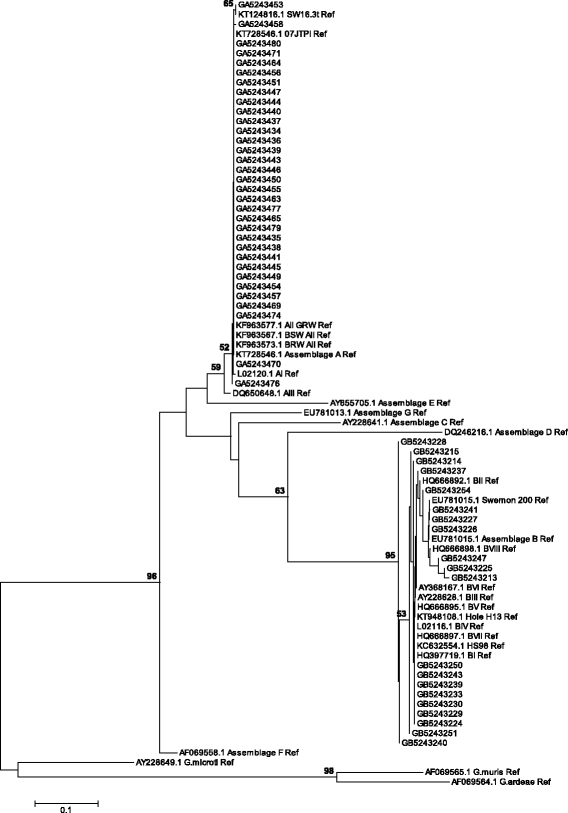Molecular epidemiology of Giardia duodenalis infection in humans in Southern Ethiopia: a triosephosphate isomerase gene-targeted analysis
- PMID: 29502512
- PMCID: PMC5836388
- DOI: 10.1186/s40249-018-0397-4
Molecular epidemiology of Giardia duodenalis infection in humans in Southern Ethiopia: a triosephosphate isomerase gene-targeted analysis
Abstract
Background: Giardia duodenalis is a species complex consisting of multiple genetically distinct assemblages. The species imposes a major public health crisis on developing countries. However, the molecular diversity, transmission dynamics and risk factors of the species in these countries are indeterminate. This study was conducted to determine the molecular epidemiology of G. duodenalis infection in asymptomatic individuals in Southern Ethiopia.
Methods: From March to June 2014, fresh stool samples were collected from 590 randomly selected individuals. Socio-demographic data were gathered using a pre-tested structured questionnaire. The genotyping was done using triosephosphate isomerase gene-based nested polymerase chain reaction and DNA sequencing. The genetic identity and relatedness of isolates were determined using the basic local alignment search tool and phylogenetic analysis. Risk factors associated with G. duodenalis infection were analysed using binary and multinomial logistic regression models.
Results: The results showed that 18.1% (92/509) of the study subjects were infected by G. duodenalis. Among the isolates, 35.9% (33/92) and 21.7% (20/92) were sub-typed into assemblages A and B, respectively, whereas 42.4% (39/92) showed mixed infections of A and B. Most of the assemblage A isolates (94%,31/33) were 100% identical to sequences registered in GenBank, of which the majority belonged to sub-assemblage AII. However, the high genetic variability and frequency of double peaks made sub-genotyping of assemblage B more problematic and only 20% (4/20) of the isolates matched 100% with the sequences. The risk factors of age (P = 0.032) and type of drinking water source (P = 0.003) both showed a significant association with the occurrence G. duodenalis infection.
Conclusions: This study established the endemicity of G. duodenalis in Southern Ethiopia. Infection with assemblage A was more frequent than with assemblage B, and the rate of infection was higher in children and in municipal/tap and open spring water consumers than the other groups. Sub-typing of assemblage B and determining the origin of double peaks were challenging. The present study confirms the need for further inclusive studies to be conducted focusing on sub-types of assemblage B and the origin of heterogeneity.
Keywords: Assemblage; Ethiopia; Giardia duodenalis; Molecular epidemiology; Risk factors; Triosephosphate isomerase gene.
Conflict of interest statement
Ethics approval and consent to participate
The Internal Review Board of the Public Health and Medical Sciences College, Jimma University, Ethiopia reviewed and approved the study protocol and permitted the research activities. The written consent and assent (in the case of children under 16) forms of the study were read out or translated to the study participants and children’s parents or legal guardians in their own language, as well as objective of the study was fully explained to them. All the participants received the questionnaire that included questions about their age, sex and residence, types and climatic zones of potable water sources and conditions of water storage at home level. Only volunteer participants who understood and agreed with the basis and procedures of the study signed the informed forms and participated in the study. During sample collection, parts of the stool samples were taken to the nearby health centres/hospitals and
Consent for publication
Not applicable.
Competing interests
The authors declare that they have no competing interests.
Figures

Similar articles
-
Multilocus genotyping of Giardia duodenalis isolates from children in Oromia Special Zone, central Ethiopia.BMC Microbiol. 2016 May 21;16:89. doi: 10.1186/s12866-016-0706-7. BMC Microbiol. 2016. PMID: 27209324 Free PMC article.
-
Molecular genotyping of Giardia duodenalis in children from Behbahan, southwestern Iran.Parasitol Res. 2018 May;117(5):1425-1431. doi: 10.1007/s00436-018-5826-6. Epub 2018 Mar 14. Parasitol Res. 2018. PMID: 29541855
-
Molecular Genotyping of Giardia duodenalis Isolates from Symptomatic Individuals Attending Two Major Public Hospitals in Madrid, Spain.PLoS One. 2015 Dec 7;10(12):e0143981. doi: 10.1371/journal.pone.0143981. eCollection 2015. PLoS One. 2015. PMID: 26641082 Free PMC article.
-
Giardiasis: a review on assemblage distribution and epidemiology in India.Indian J Gastroenterol. 2012 Jan;31(1):3-12. doi: 10.1007/s12664-012-0161-9. Epub 2012 Feb 7. Indian J Gastroenterol. 2012. PMID: 22311296 Review.
-
Molecular epidemiology of giardiasis from a veterinary perspective.Adv Parasitol. 2019;106:209-254. doi: 10.1016/bs.apar.2019.07.002. Epub 2019 Aug 7. Adv Parasitol. 2019. PMID: 31630759 Review.
Cited by
-
Prevalence and genotypic characterization of Giardia duodenalis isolates from asymptomatic school-going children in Lusaka, Zambia.Food Waterborne Parasitol. 2020 Feb 21;19:e00072. doi: 10.1016/j.fawpar.2020.e00072. eCollection 2020 Jun. Food Waterborne Parasitol. 2020. PMID: 32258446 Free PMC article.
-
Anti-protozoal potential of electrospun polymeric nanofiber composite membranes for treatment of contaminated drinking water.Pathog Glob Health. 2025 Feb-Mar;119(1-2):29-47. doi: 10.1080/20477724.2025.2460006. Epub 2025 Feb 6. Pathog Glob Health. 2025. PMID: 39911055
-
Genetic analysis of Giardia duodenalis isolates from children of low-income families living in an economically successful region in Southeastern Brazil.Rev Inst Med Trop Sao Paulo. 2020 Mar 30;62:e20. doi: 10.1590/S1678-9946202062020. eCollection 2020. Rev Inst Med Trop Sao Paulo. 2020. PMID: 32236387 Free PMC article.
-
Prevalence and assemblage of Giardia duodenalis in a case-control study of children under 5 years from Jimma, Southwest Ethiopia.Parasitol Res. 2023 Dec 13;123(1):38. doi: 10.1007/s00436-023-08029-5. Parasitol Res. 2023. PMID: 38091122 Free PMC article.
-
The opportunistic protist, Giardia intestinalis, occurs in gut-healthy humans in a high-income country.Emerg Microbes Infect. 2023 Dec;12(2):2270077. doi: 10.1080/22221751.2023.2270077. Epub 2023 Oct 27. Emerg Microbes Infect. 2023. PMID: 37815802 Free PMC article.
References
-
- Durigan M, Abreu AG, Zucchi MI, Franco RMB, de Souza AP. Genetic diversity of Giardia duodenalis: multilocus genotyping reveals zoonotic potential between clinical and environmental sources in a metropolitan region of Brazil. PLoS One. 2014;9(12):e115489. doi: 10.1371/journal.pone.0115489. - DOI - PMC - PubMed
-
- Lobo ML, Augusto J, Antunes F, Ceita J, Xiao L, Codices V, et al. Cryptosporidium spp., Giardia duodenalis, Enterocytozoon bieneusi and other intestinal parasites in young children in Lobata Province, Democratic Republic of Sao Tome and Principe. PLoS One. 2014;9:e97708. doi: 10.1371/journal.pone.0097708. - DOI - PMC - PubMed
MeSH terms
Substances
LinkOut - more resources
Full Text Sources
Other Literature Sources
Medical
Miscellaneous

